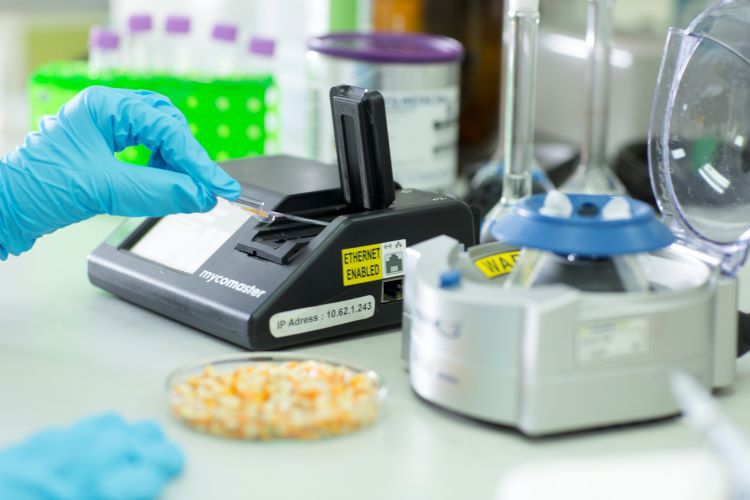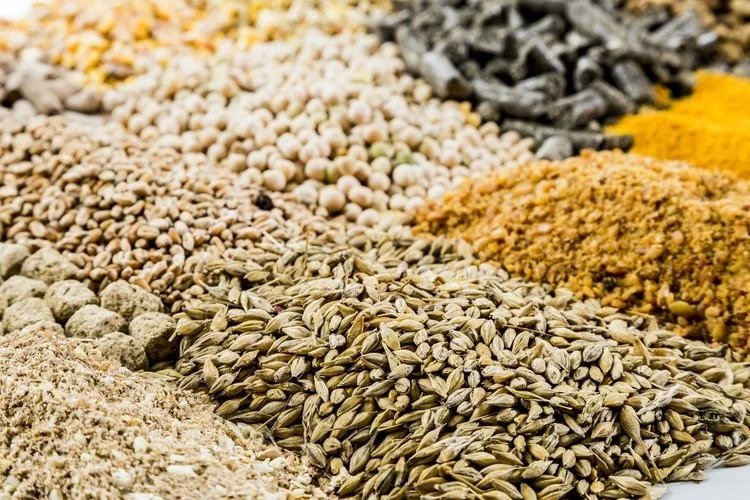Mycotoxin risk management programme
Mycotoxin risk management Contamination of raw materials with mycotoxins in the field or during storage at feed mills is a significant challenge in maintaining the quality of final feed. Failure to achieve high quality of feed can mean economic losses for feed millers as a result of poor feed prices, diminished brand image and compromised performance of animals.
Mycotoxins produced by moulds are a growing problem in feed production. Trouw Nutrition’s integrated Mycotoxin risk management programme enables feed producers to make data-based decisions and use mycotoxin control solutions more precisely to address this issue.
This programme is proven to reduce overall mycotoxin risk by a 3D approach: Risk identification, quality control and application of solutions.
Global Mycotoxin Review 2023 - 2024
In this webinar recording, we explore insights from over 65,000 mycotoxin analyses conducted in 2023, offering invaluable strategies for effective risk management in 2024. Dr. Swamy Haladi, Selko’s Global Technical Commercial Manager, provides global-level guidance on navigating this extensive dataset. Joining him is Mr. Avinash Bhat, Technical Specialist at Masterlab, offering innovative perspectives on interpreting and forecasting the data. Gain expert insights to optimise mycotoxin risk management for your operations.
Identifying the risks
To help identify the risk of mycotoxins in feed on the farm, Trouw Nutrition offers Mycomaster, a lateral-flow smart device that provides a reliable quantitative reading of the contamination levels in feed materials and compound feed. It enables rapid on-site, cost-effective and user-friendly analysis of six different mycotoxins: Zearalenone, Deoxynivalenol, Aflatoxins, Fumonisins, Ochratoxin and T2-HT2.
This easy-to-use tool gives results within 15-30 minutes, which means that feed producers can analyse mycotoxins themselves. It can also be connected to Trouw Nutrition's global data exchange system, allowing the review of data collected from all over the globe.


Ensuring proper quality control
Since mycotoxins are produced by moulds, it is important that raw materials and feed are stored properly at feed mill or farm level. Quality control is key: new materials should be tested upon arrival to detect contamination levels and even reject raw materials if mycotoxin levels are exceeding guidance values.
Proper hygiene measures are also crucial on the farm to prevent mould and mycotoxin development at a later stage. For example, regular cleaning of feed troughs will prevent residue feed from getting mouldy. Pay special attention to silage, which can be prone to mould growth due to the favourable conditions during storage.
Finally, animal performance should be monitored closely, to detect any symptoms of increased mycotoxin levels.
"Constant exposure to mycotoxins may lead to chronic toxicity and economic losses. A comprehensive mycotoxin risk management programme should be in place to prevent and reduce such economic losses."
Powerful solutions
Once raw material or feed quality have been assessed and the mycotoxin levels identified, you may need to take actions to prevent mycotoxins from affecting animal health and performance.
Trouw Nutrition’s TOXO products provide a complete solution against a broad spectrum of mycotoxins, combining four main modes of actions, designed to support animal health and performance during mycotoxin exposure.
- Effective absorption ability through smectite-based bentonite clays has been proven by numerous in vivo and in vitro validation studies. These ingredients do not bind to other valuable nutrients in feed.
- Support for gut integrity through specific glucose biopolymers, reinforcing enterocyte tight junction protein complexes, which are damaged by inflammation during mycotoxin exposure.
- Immune system modulation through highly purified Beta glucans, which act as immune modulating agents with proven in vivo and in vivo efficacy.
- Anti-oxidative support through specific antioxidants and vitamins that promote the metabolism of mycotoxins in the liver.

Frequently asked questions
What is the role of a mycotoxin adsorbent?
Adsorbents, or binders can be very effective for certain mycotoxins, but not all. The physiological complexity in the gut may compromise binding efficacy and, therefore, it is not wise to rely on a toxin binder alone.
Can I rely solely on mycotoxin binders?
We recommend that you combine binders with other functional ingredients that can mitigate the toxicity of mycotoxins. An integrated binding and remediation strategy can help minimize the negative impact of mycotoxins on animal health and performance. TOXO-XL contains ingredients that support this combined strategy.
Can I use mould inhibitors to prevent mycotoxins – is that enough?
Mould control is important, but not alone sufficient to prevent mycotoxin occurrence. Since mycotoxins are metabolites of moulds, they can be produced even while crops are growing in the field. Once present, most mycotoxins cannot be removed through acidification or heating and other strategies are needed to prevent them from impacting animal performance. So, even when moulds are removed at any step of the feed production chain, mycotoxins that were already present will continue to pose a risk.
Is there a cumulative effect when low levels of mycotoxins are consumed over a longer period of time?
Absolutely, yes. Chronic exposure to multiple mycotoxins, though each may be at a low-risk level individually, can drive down animal health and performance.
MycoBite video series
MycoBites is a series with comprehencive and practical explanations about various topics in Mycotoxin Risk Managment. In this series of six episodes, Dr. Swamy Haladi, Global Technical Commercial Manager for Selko will touch upon various aspects related to mycotoxin analysis